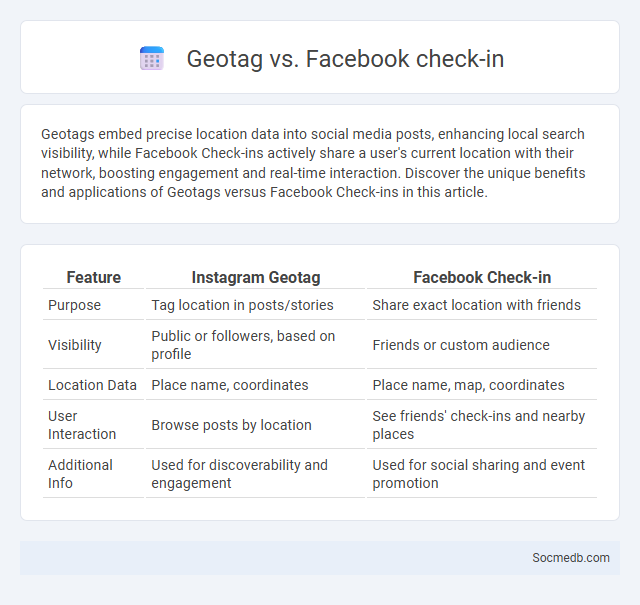
Photo illustration: Geotag vs Facebook Check-in
Geotags embed precise location data into social media posts, enhancing local search visibility, while Facebook Check-ins actively share a user's current location with their network, boosting engagement and real-time interaction. Discover the unique benefits and applications of Geotags versus Facebook Check-ins in this article.
Table of Comparison
| Feature | Instagram Geotag | Facebook Check-in |
|---|---|---|
| Purpose | Tag location in posts/stories | Share exact location with friends |
| Visibility | Public or followers, based on profile | Friends or custom audience |
| Location Data | Place name, coordinates | Place name, map, coordinates |
| User Interaction | Browse posts by location | See friends' check-ins and nearby places |
| Additional Info | Used for discoverability and engagement | Used for social sharing and event promotion |
Introduction to Location-Based Services
Location-Based Services (LBS) leverage social media platforms to deliver personalized content and enhance user experience by utilizing geographic data. These services enable real-time check-ins, localized recommendations, and targeted advertisements, increasing engagement and relevance for Your social interactions. By integrating GPS technology and social networking, LBS transform how users connect with their surroundings and discover nearby events or businesses.
What is a Geotag?
A geotag is metadata embedded in social media posts that includes geographical information such as latitude and longitude coordinates, linking content to a specific location. This tool enhances user engagement by allowing photos, videos, or statuses to be discoverable based on place-based searches and facilitates location-based marketing strategies. Geotags are widely used on platforms like Instagram, Facebook, and Twitter to promote local businesses, track event participation, and analyze audience demographics by location.
How Facebook Check-in Works
Facebook Check-in allows users to share their exact location with friends by tagging a specific place in their post, event, or status update. This feature uses GPS data from the user's device and overlays it with Facebook's location database, enabling real-time location sharing and enhancing social interactions. Businesses and venues benefit by gaining increased visibility and engagement when users check in at their locations.
Geotag vs Facebook Check-in: Key Differences
Geotags embed precise geographic coordinates in social media posts, enabling location-based content discovery and improving SEO by linking posts to specific places. Facebook Check-ins, conversely, allow users to publicly share their presence at a location, offering social validation and fostering community engagement through visible user activity. Geotags primarily enhance data accuracy and searchability, while Facebook Check-ins emphasize real-time social interaction and location-based networking.
Privacy Implications of Geotagging
Geotagging on social media platforms exposes users' real-time locations, increasing vulnerability to stalking, theft, and unauthorized tracking. Sharing precise location data can inadvertently reveal patterns in daily routines, compromising personal safety and privacy. Users must manage geotag settings and understand platform-specific privacy controls to mitigate these risks effectively.
Benefits of Using Geotags
Geotags enhance social media engagement by providing location-specific context that increases content visibility and user interaction. They facilitate targeted marketing strategies by allowing businesses to reach local audiences effectively and track customer behavior patterns. Utilizing geotags also improves discoverability in location-based searches, boosting organic reach and driving foot traffic to physical stores or events.
Advantages of Facebook Check-ins for Users
Facebook Check-ins enhance Your social media experience by allowing easy sharing of real-time locations, fostering stronger connections with friends and family through personal updates. These check-ins boost local business visibility and discoveries, helping You explore new places and events based on trusted social circles. Privacy controls ensure You maintain control over who sees Your check-ins, balancing social sharing with personal security.
Use Cases for Geotagging and Check-ins
Geotagging and check-ins enhance social media by enabling location-based marketing, increasing user engagement through local content, and facilitating event discovery for your audience. Businesses leverage geotags to target ads and promotions precisely, while users share real-time experiences tied to specific places, boosting authenticity and reach. These features also help in analyzing foot traffic patterns and customer behavior to optimize services and campaigns effectively.
Common Mistakes in Location-Based Tagging
Common mistakes in location-based tagging on social media include inaccurate geotags that mislead followers, over-tagging multiple irrelevant locations, and failing to update location information promptly. These errors can reduce engagement rates and decrease the credibility of posts on platforms like Instagram and Facebook. Proper use of precise location tags enhances discoverability, improves local SEO, and strengthens community interaction.
Choosing the Right Location Feature for Your Needs
Selecting the right location feature on social media platforms enhances your content's visibility and engagement by targeting audiences based on geographic relevance. Many platforms offer options such as tagged locations, geofilters, and check-ins, allowing you to customize your posts to reach local communities or broader regions effectively. Understanding how to leverage these tools ensures your social media strategy aligns with your specific marketing goals and audience preferences.
 socmedb.com
socmedb.com